Art print | The city guard - Carl Spitzweg Source: Reproduction | La garde de la ville - Carl Spitzweg


View from behind

Frame (optional)
Art print La garde de la ville - Carl Spitzweg – Engaging introduction
In the rich and complex universe of 19th-century art, the work "La garde de la ville" by Carl Spitzweg stands out for its ability to capture the essence of everyday life while evoking a certain melancholy. This painting, which depicts a moment of vigilance and contemplation, invites the viewer to immerse themselves in a world where tranquility borders on alertness. The characters, frozen in a suspended moment, bear witness to a universal humanity rooted in the historical context of the time. Contemplating this piece, one feels the breath of time, an echo of the social and cultural concerns that traversed Europe during that era. Spitzweg's art offers us not only a window into the past but also a reflection on the human condition.
Style and uniqueness of the work
Carl Spitzweg's style is characterized by delicacy and meticulous attention to detail, features of German Romanticism. In "La garde de la ville," warm colors and subtle nuances create an atmosphere that is both serene and emotionally charged. The characters, although depicted in a vigilant setting, exude a certain tranquility, almost contemplative. The composition, balanced and harmonious, guides the viewer's eye across the painting, revealing narrative elements that enrich the visual experience. The lighting, carefully crafted, plays a crucial role in highlighting forms and textures, creating a striking contrast between shadow and light. This artwork is not merely a simple representation; it invites introspection and a connection with fundamental human emotions.
The artist and his influence
Carl Spitzweg, born in 1808 in Munich, is one of the most emblematic artists of the Romantic movement in Germany. His career, marked by a wide variety of subjects ranging from peasant life to genre scenes, reflects a deep interest in human nature and society of his time. Spitzweg was able to capture the nuances of daily life with a sensitivity unique to him. His influence extends beyond his era, inspiring many artists and continuing to fascinate art enthusiasts. Through his works, he was able to translate aspirations and the

Matte finish

View from behind

Frame (optional)
Art print La garde de la ville - Carl Spitzweg – Engaging introduction
In the rich and complex universe of 19th-century art, the work "La garde de la ville" by Carl Spitzweg stands out for its ability to capture the essence of everyday life while evoking a certain melancholy. This painting, which depicts a moment of vigilance and contemplation, invites the viewer to immerse themselves in a world where tranquility borders on alertness. The characters, frozen in a suspended moment, bear witness to a universal humanity rooted in the historical context of the time. Contemplating this piece, one feels the breath of time, an echo of the social and cultural concerns that traversed Europe during that era. Spitzweg's art offers us not only a window into the past but also a reflection on the human condition.
Style and uniqueness of the work
Carl Spitzweg's style is characterized by delicacy and meticulous attention to detail, features of German Romanticism. In "La garde de la ville," warm colors and subtle nuances create an atmosphere that is both serene and emotionally charged. The characters, although depicted in a vigilant setting, exude a certain tranquility, almost contemplative. The composition, balanced and harmonious, guides the viewer's eye across the painting, revealing narrative elements that enrich the visual experience. The lighting, carefully crafted, plays a crucial role in highlighting forms and textures, creating a striking contrast between shadow and light. This artwork is not merely a simple representation; it invites introspection and a connection with fundamental human emotions.
The artist and his influence
Carl Spitzweg, born in 1808 in Munich, is one of the most emblematic artists of the Romantic movement in Germany. His career, marked by a wide variety of subjects ranging from peasant life to genre scenes, reflects a deep interest in human nature and society of his time. Spitzweg was able to capture the nuances of daily life with a sensitivity unique to him. His influence extends beyond his era, inspiring many artists and continuing to fascinate art enthusiasts. Through his works, he was able to translate aspirations and the






